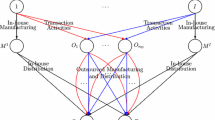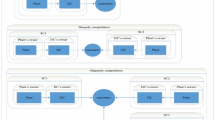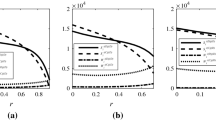Abstract
This paper develops a supply chain network game theory framework with multiple manufacturers/producers, with multiple manufacturing plants, who own distribution centers and distribute their products, which are distinguished by brands, to demand markets, while maximizing profits and competing noncooperatively. The manufacturers also may avail themselves of external distribution centers for storing their products and freight service provision. The manufacturers have capacities associated with their supply chain network links and the external distribution centers also have capacitated storage and distribution capacities for their links, which are shared among the manufacturers and competed for. We utilize a special case of the Generalized Nash Equilibrium problem, known as a variational equilibrium, in order to formulate and solve the problem. A case study on apple farmers in Massachusetts is provided with various scenarios, including a supply chain disruption, to illustrate the modeling and methodological framework as well as the potential benefits of outsourcing in this sector.







Similar content being viewed by others
References
Aguiar e Oliveira Jr., H., Petraglia, A.: Solving generalized Nash equilibrium through stochastic global optimization. Appl. Soft Comput. 39, 21–35 (2016)
Andel, T.: There’s power in numbers. Transp. Distrib. 36, 67–72 (1995)
Ang, J., Fukushima, M., Meng, F., Noda, T., Sun, J.: Establishing Nash equilibrium of the manufacturer–supplier game in supply chain management. J. Glob. Optim. 56, 1297–1312 (2013)
Ardagna, D., Panicucci, B., Passcantando, M.: Generalized Nash equilibria for the service provisioning problem in cloud systems. IEEE Trans. Serv. Comput. 6(4), 429–442 (2013)
Arrow, K.J., Debreu, G.: Existence of an equilibrium for a competitive economy. Econometrica 22, 265–290 (1954)
Bensoussan, A.: Points de Nash dans le cas de fonctionelles quadratiques et jeux differentiels lineaires a N personnes. SIAM J. Control 12, 460–499 (1974)
Berkett, L.P. (ed.): Management Guide for Low-input Sustainable Apple Production. DIANE Publishing, Collingdale, Pennsylvania (1994)
Brennen, M., Golden, J.: UPS FedEx and DHL bet big on health-care logistics. CNBC.com, October 2. http://www.cnbc.com/2015/10/02/ups-fedex-and-dhl-bet-big-on-health-care-logistics.html (2015)
Chinchuluun, A., Pardalos, P.M., Migdalas, A., Pitsoulis, L. (eds.): Pareto Optimality, Game Theory and Equilibria. Springer, New York (2008)
CISA. http://www.farmfresh.org/food/farmersmarkets.php?zip=01002 (2016)
Contreras, J., Klusch, M., Krawczyk, J.: Numerical solutions to Nash–Cournot equilibria in coupled constraint electricity markets. IEEE Trans. Power Syst. 19(1), 195–206 (2004)
Cooke, J.A.: Sharing supply chains for mutual gain. In: CSCMP’s Supply Chain Quarterly. http://www.supplychainquarterly.com/topics/Global/scq201102kimberly/ (2011)
Debreu, G.: A social equilibrium existence theorem. Proc. Natl. Acad. Sci. USA 38, 886–893 (1952)
Dunning, R.: Market channel evaluation: produce. North Carolina Growing Together. http://www.cefs.ncsu.edu/ncgt/market-channel-evaluation-produce (2014)
Dupuis, P., Nagurney, A.: Dynamical systems and variational inequalities. Ann. Oper. Res. 44, 9–42 (1993)
Facchinei, F., Kanzow, C.: Generalized Nash equilibrium problems. Ann. Oper. Res. 175, 177–211 (2010)
Fischer, A., Herrich, M., Schonefeld, K.: Generalized Nash equilibrium problems—recent advances and challenges. Pesqui. Oper. 34(3), 521–558 (2014)
Gabay, D., Moulin, H.: On the uniqueness and stability of Nash equilibria in noncooperative games. In: Bensoussan, A., Kleindorfer, P., Tapiero, C.S. (eds.) Applied Stochastic Control of Econometrics and Management Science, pp. 271–294. North-Holland, Amsterdam (1980)
Inbound Logistics.: How to drive collaborative distribution. November. http://www.inboundlogistics.com/cms/article/how-to-drive-collaborative-distribution/ (2010)
Jiang, H., Pang, Z.: Network capacity management under competition. Comput. Optim. Appl. 50(2), 287–326 (2011)
Krawczyk, J.B.: Coupled constraint Nash equilibria in environmental games. Resour. Energy Econ. 27, 157–181 (2005)
Kulkarni, A.A., Shanbhag, U.V.: On the variational equilibrium as a refinement of the generalized Nash equilibrium. Automatica 48, 45–55 (2012)
Langley Jr., C.J.: 2016 third-party logistics study: the state of logistics outsourcing. http://www.3plstudy.com/media/downloads/2015/09/3pl_report-final_reduced_size (2015)
Li, P., Lin, G.: Solving a class of generalized Nash equilibrium problems. J. Math. Res. Appl. 33(3), 372–378 (2013)
Li, D., Nagurney, A.: Supply chain performance assessment and supplier and component importance identification in a general competitive multitiered supply chain network model. J. Glob. Optim. 67(1), 223–250 (2017)
Luna, J.P.: Decomposition and Approximation Methods for Variational Inequalities, with Applications to Deterministic and Stochastic Energy Markets. PhD thesis, Instituto Nacional de Matematica Pura e Aplicada, Rio de Janeiro, Brazil (2013)
Masoumi, A.H., Yu, M., Nagurney, A.: A supply chain generalized network oligopoly model for pharmaceuticals under brand differentiation and perishability. Transp. Res. E 48, 762–780 (2012)
Miles, A., Brown, M.: Teaching Direct Marketing and Small Farm Viability: Resources for Instructors. California, Center for Agroecology & Sustainable Food Systems, University of California Santa Cruz, Santa Cruz (2005)
Nagurney, A.: Network Economics: A Variational Inequality Approach, 2 and revised edn. Kluwer Academic Publishers, Boston (1999)
Nagurney, A.: Supply Chain Network Economics: Dynamics of Prices, Flows, and Profits. Edward Elgar Publishing, Cheltenham (2006)
Nagurney, A.: Formulation and analysis of horizontal mergers among oligopolistic firms with insights into the merger paradox: a supply chain network perspective. Comput. Manag. Sci. 7, 377–401 (2010)
Nagurney, A., Alvarez Flores, E., Soylu, C.: A generalized Nash equilibrium model for post-disaster humanitarian relief. Transp. Res. E 95, 1–18 (2016)
Nagurney, A., Dong, J., Zhang, D.: A supply chain network equilibrium model. Transp. Res. E 38(5), 281–303 (2002)
Nagurney, A., Dupuis, P., Zhang, D.: A dynamical systems approach for network oligopolies and variational inequalities. Ann. Reg. Sci. 28, 263–283 (1994)
Nagurney, A., Yu, M.: Sustainable fashion supply chain management under oligopolistic competition and brand differentiation. Int. J. Prod. Econ. 135, 532–540 (2012)
Nagurney, A., Yu, M., Floden, J.: Supply chain network sustainability under competition and frequencies of activities from production to distribution. Comput. Manag. Sci. 10(4), 397–422 (2013)
Nagurney, A., Yu, M., Floden, J.: Fashion supply chain network competition with ecolabelling. In: Choi, T.-M., Cheng, T.C.E. (eds.) Sustainable Fashion Supply Chain Management: From Sourcing to Retailing, pp. 61–84. Springer, New York (2015)
Nagurney, A., Zhang, D.: Projected Dynamical Systems and Variational Inequalities with Applications. Kluwer Academic Publishers, Norwell (1996)
Nash, J.F.: Equilibrium points in n-person games. Proc. Natl. Acad. Sci. USA 36, 48–49 (1950)
Nash, J.F.: Noncooperative games. Ann. Math. 54, 286–298 (1951)
Passacatando, M., Ardagna, D., Savi, A.: Service provisioning problem in cloud and multi-cloud systems. INFORMS J. Comput. 28(2), 265–277 (2016)
Pharmaceutical Commerce.: UPS officially opens three new healthcare logistics facilities in Asia-Pacific, January 3. http://pharmaceuticalcommerce.com/supply-chain-logistics/ups-officially-opens-three-new-healthcare-logistics-facilities-in-asia-pacific/ (2013)
Phillips, E.E.: Collaborative logistics comes to the warehouse. Wall Street Journal, June 12 (2015)
Qiang, Q., Ke, K., Anderson, T., Dong, J.: The closed-loop supply chain network with competition, distribution channel investment, and uncertainties. Omega 41, 186–194 (2013)
Rosen, J.B.: Existence and uniqueness of equilibrium points for concave N-person games. Econometrica 33, 520–534 (1965)
Simchi-Levi, D., Kaminsky, P., Simchi-Levi, E.: Designing and Managing the Supply Chain: Concepts, Strategies, and Case Studies. McGraw-Hill/Irwin, New York (2000)
Toyasaki, F., Daniele, P., Wakolbinger, T.: A variational inequality formulation of equilibrium models for end-of-life products with nonlinear constraints. Eur. J. Oper. Res. 236, 340–350 (2014)
von Heusinger, A.: Numerical Methods for the Solution of the Generalized Nash Equilibrium Problem. PhD Dissertation, University of Wurtburg, Germany (2009)
World Economic Forum.: How can digital help logistics be more sharing? http://reports.weforum.org/digital-transformation-of-industries/cutting-costs-through-sharing-logistics-assets/ (2016)
Yashtini, M., Malek, A.: Solving complementarity and variational inequality problems using neural networks. Appl. Math. Comput. 190, 216–239 (2007)
Yu, M., Nagurney, A.: Competitive food supply chain networks with application to fresh produce. Eur. J. Oper. Res. 224(2), 273–282 (2013)
Acknowledgements
The authors are grateful to two anonymous reviewers and to the Editor for helpful comments and suggestions on an earlier version of this paper.
Author information
Authors and Affiliations
Corresponding author
Rights and permissions
About this article
Cite this article
Nagurney, A., Yu, M. & Besik, D. Supply chain network capacity competition with outsourcing: a variational equilibrium framework. J Glob Optim 69, 231–254 (2017). https://doi.org/10.1007/s10898-017-0497-x
Received:
Accepted:
Published:
Issue Date:
DOI: https://doi.org/10.1007/s10898-017-0497-x




